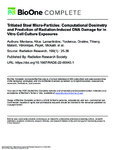Tritiated Steel Micro-Particles: Computational Dosimetry and Prediction of Radiation-Induced DNA Damage for In Vitro Cell Culture Exposures
| dc.contributor.author | Mentana, A | |
| dc.contributor.author | Lamartinière, Y | |
| dc.contributor.author | Orsière, T | |
| dc.contributor.author | Malard, V | |
| dc.contributor.author | Payet, M | |
| dc.contributor.author | Slomberg, D | |
| dc.contributor.author | Guardamagna, I | |
| dc.contributor.author | Lonati, L | |
| dc.contributor.author | Grisolia, C | |
| dc.contributor.author | Jha, Awadhesh | |
| dc.contributor.author | Lebaron-Jacobs, L | |
| dc.contributor.author | Rose, J | |
| dc.contributor.author | Ottolenghi, A | |
| dc.contributor.author | Baiocco, G | |
| dc.date.accessioned | 2023-02-14T11:20:19Z | |
| dc.date.issued | 2022-11-28 | |
| dc.identifier.issn | 0033-7587 | |
| dc.identifier.issn | 1938-5404 | |
| dc.identifier.uri | http://hdl.handle.net/10026.1/20342 | |
| dc.description.abstract |
Biological effects of radioactive particles can be experimentally investigated in vitro as a function of particle concentration, specific activity and exposure time. However, a careful dosimetric analysis is needed to elucidate the role of radiation emitted by radioactive products in inducing cyto- and geno-toxicity: the quantification of radiation dose is essential to eventually inform dose-risk correlations. This is even more fundamental when radioactive particles are short-range emitters and when they have a chemical speciation that might further concur to the heterogeneity of energy deposition at the cellular and sub-cellular level. To this aim, we need to use computational models. In this work, we made use of a Monte Carlo radiation transport code to perform a computational dosimetric reconstruction for in vitro exposure of cells to tritiated steel particles of micrometric size. Particles of this kind have been identified as worth of attention in nuclear power industry and research: tritium easily permeates in steel elements of nuclear reactor machinery, and mechanical operations on these elements (e.g., sawing) during decommissioning of old facilities can result in particle dispersion, leading to human exposure via inhalation. Considering the software replica of a representative in vitro setup to study the effect of such particles, we therefore modelled the radiation field due to the presence of particles in proximity of cells. We developed a computational approach to reconstruct the dose range to individual cell nuclei in contact with a particle, as well as the fraction of “hit” cells and the average dose for the whole cell population, as a function of particle concentration in the culture medium. The dosimetric analysis also provided the basis to make predictions on tritium-induced DNA damage: we estimated the dose-dependent expected yield of DNA double strand breaks due to tritiated steel particle radiation, as an indicator of their expected biological effectiveness. | |
| dc.format.extent | 25-38 | |
| dc.format.medium | ||
| dc.language | eng | |
| dc.language.iso | eng | |
| dc.publisher | Radiation Research Society | |
| dc.subject | Humans | |
| dc.subject | Tritium | |
| dc.subject | Radiometry | |
| dc.subject | Cell Nucleus | |
| dc.subject | Cell Culture Techniques | |
| dc.subject | DNA Damage | |
| dc.title | Tritiated Steel Micro-Particles: Computational Dosimetry and Prediction of Radiation-Induced DNA Damage for In Vitro Cell Culture Exposures | |
| dc.type | journal-article | |
| dc.type | Journal Article | |
| dc.type | Research Support, Non-U.S. Gov't | |
| plymouth.author-url | https://www.webofscience.com/api/gateway?GWVersion=2&SrcApp=PARTNER_APP&SrcAuth=LinksAMR&KeyUT=WOS:000908411200003&DestLinkType=FullRecord&DestApp=ALL_WOS&UsrCustomerID=11bb513d99f797142bcfeffcc58ea008 | |
| plymouth.issue | 1 | |
| plymouth.volume | 199 | |
| plymouth.publication-status | Published | |
| plymouth.journal | Radiation Research | |
| dc.identifier.doi | 10.1667/rade-22-00043.1 | |
| plymouth.organisational-group | /Plymouth | |
| plymouth.organisational-group | /Plymouth/Admin Group - REF | |
| plymouth.organisational-group | /Plymouth/Admin Group - REF/REF Admin Group - FoSE | |
| plymouth.organisational-group | /Plymouth/Faculty of Science and Engineering | |
| plymouth.organisational-group | /Plymouth/Faculty of Science and Engineering/School of Biological and Marine Sciences | |
| plymouth.organisational-group | /Plymouth/REF 2021 Researchers by UoA | |
| plymouth.organisational-group | /Plymouth/REF 2021 Researchers by UoA/UoA06 Agriculture, Veterinary and Food Science | |
| plymouth.organisational-group | /Plymouth/Research Groups | |
| plymouth.organisational-group | /Plymouth/Research Groups/Marine Institute | |
| plymouth.organisational-group | /Plymouth/Users by role | |
| plymouth.organisational-group | /Plymouth/Users by role/Academics | |
| plymouth.organisational-group | /Plymouth/Users by role/Researchers in ResearchFish submission | |
| dc.publisher.place | United States | |
| dcterms.dateAccepted | 2022-10-24 | |
| dc.rights.embargodate | 2023-2-15 | |
| dc.identifier.eissn | 1938-5404 | |
| dc.rights.embargoperiod | Not known | |
| rioxxterms.funder | European Commission | |
| rioxxterms.identifier.project | Transversal actions for Tritium | |
| rioxxterms.versionofrecord | 10.1667/rade-22-00043.1 | |
| rioxxterms.licenseref.uri | http://www.rioxx.net/licenses/all-rights-reserved | |
| rioxxterms.licenseref.startdate | 2023-01-01 | |
| rioxxterms.type | Journal Article/Review | |
| plymouth.funder | Transversal actions for Tritium::European Commission |


